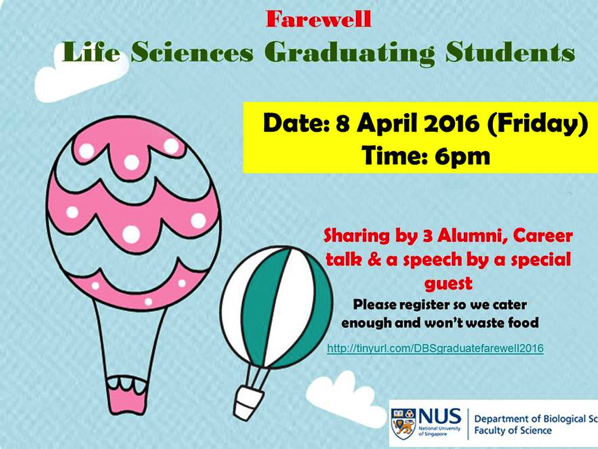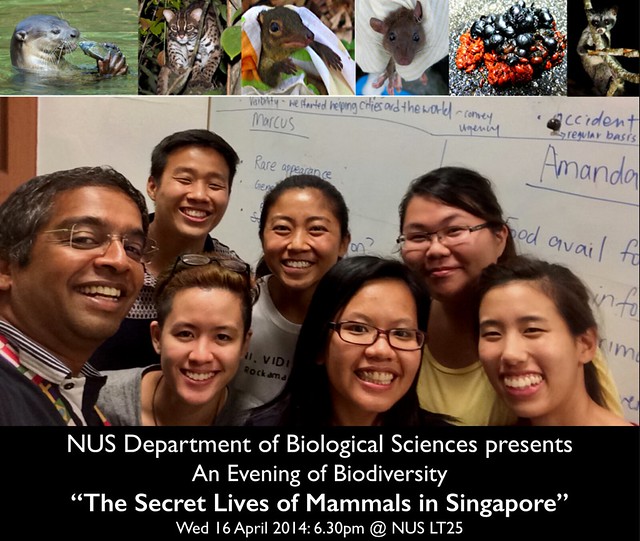I am glad to announce “An Evening of Biodiversity: The Secret Lives of Mammals in Singapore” presented by six young graduates of the Department of Biological Sciences, National University of Singapore. They share with us short stories about wild mammals from their recent student research and their hopes for Singapore’s wildlife and heritage.
Come and be surprised by the stories about Singapore’s wild leopard cats, small mammals, smooth-coated otters and the common palm civet. The graduates, Amanda Tan, Chloe Tan, Marcus Chua, Meryl Theng, Fung Tze Kwan & Xu Weiting do this as part of a desire to contribute to public awareness and the protection of our fragile ecosystems.
And they look forward to entertaining the audience!
An Evening of Biodiversity will be held on
Wed 16 Apr 2014: 6.30pm – 8.30pm
Lecture Theatre 25 (next to the Science Canteen)
Science Drive 2
National University of Singapore
Please RSVP at http://tinyurl.com/eob2014-reg
Map: http://map.sivasothi.com
(Parking is available at Car Park 10 across the road)
Veteran vertebrate naturalist Yeo Suay Hwee of the Nature Society (Singapore) had these kind words for the group,
“I hope this kind of presentation become a tradition where I can see more and more young scientists and new graduates/undergraduates ready to contribute in protecting our fragile wildlife and the habitat.”
We do look forward to your company.
Do RSVP if you are able to join us and feel free to forward this invitation to family, friends and colleagues.
Thank you!
Cheerio!
Sivasothi aka Otterman
—
N. Sivasothi
Department of Biological Sciences
National University of Singapore
About the talks
Small mammals have rarely been studied in Singapore and after over a decade Amanda Tan conducted a study of the diversity and abundance of small mammals around the Eco-Link. Once again the value of our unique, precious and fragile Bukit Timah Nature Reserve was demonstrated and the importance of the new forest connection with the Central Catchment realised.
Chloe Tan took small mammal exploration island-wide for the first time, documenting diversity in nine sites of varying forest quality. Eight species and three habitats later, she realised we cannot be hasty about connecting all our green areas – what were her concerns?
Sometimes we conduct surveys just for completeness. But on April Fool’s Day no less, the eyes of a leopard cat gleamed at Marcus Chua from amidst the undergrowth. After more than four decades, three populations provide relief about the longevity of this rare species but new issues emerge for our attention.
The smooth-coated otter (“anjing ayer”) returned to Singapore in 1998 exactly as predicted – Sungei Buloh Wetlands Reserve, where these fish-eaters enjoyed prawns too! In the northeast, otters spread from Pulau Ubin through Punggol and eventually south to Marina Bay! Meryl Theng tracked the otters, not only by foot but through the enthusiastic and generous submissions of Singaporeans delighted at the return of this wild carnivore.
The common palm civet is a wild carnivore nestled in our backyard but surprisingly poorly understood. At Pulau Ubin, poop-specialist Fung Tze Kwan was surprised to discover that civets favoured the fruits of the common fish-tail palm and improved the growth of its seedlings! When adopted as the logo of the Raffles Museum, the toddycat was entwined with a palm leaf – little did we realise this poorly studied pair was linked in an ecological partnership which may prove to be relevant in habitat restoration in the future.
As wildlife spreads in this garden city, they feel the pinch of space too. As Xu Weiting studied wildlife-human interactions, orphan civets needed care and the protocols which arose went online and helped civets elsewhere in Southeast Asia too! This furry animal is not always greeted with delight, sometime conflict arises. Awareness of these neighbourhood acrobats has helped to transform fear to delight and a hope in the hearts of young researchers of a future of greater co-existence.


 Department of Biological Sciences, NUS
Department of Biological Sciences, NUS






![47mandaimangrove-19sep2012[ssglat]](https://i0.wp.com/farm9.staticflickr.com/8440/8007444222_b15df42b4e.jpg)


